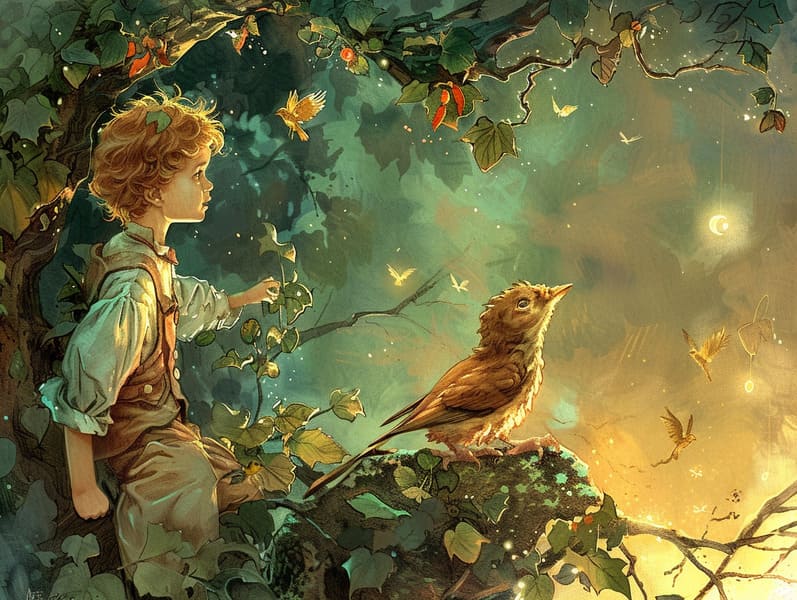
Classic fairy tales have legendary status. These stories have been narrated from one generation to the next centuries before they were ever recorded. They came from a variety of backgrounds, including European traditions. They were initially shared among grown-ups, often carrying themes and messages reflective of the societal norms and beliefs of the time.
Jacob and Wilhelm Grimm, Jacob and Wilhelm Grimm, were among the first to assemble many of these beloved narratives. Their anthology, "Grimm's Children's Stories," included stories like "Ashenputtel," "The Story of Hansel and Gretel," and "Schneewittchen," which have since become essentials in the world of timeless fairy tales. Similarly, Andersen's fantastical narratives, such as "The Mermaid," and "The Ugly Duckling," have captivated hearts worldwide, establishing their place in the pantheon of beloved fairy tales.
Despite their historical roots, fairy tales remain as meaningful as ever, especially as children's bedtime stories. These magical stories are now available in multiple formats, including gorgeously illustrated books, enchanting animations, and online fairy tales.
Their lasting appeal can be credited to several charming aspects:
Key Lessons: Old fairy tales often teach important moral lessons. Stories like "The Boy Who Cried Wolf" teach the significance of being truthful, while "The Tale of the Tortoise and the Hare" exemplify the benefits of determination and unassuming nature. These tales offer young readers clear distinctions between correct and incorrect, guiding their moral compass in a subtle yet profound way.
Warmth and Understanding: Timeless fairy tales frequently portray heroines facing problems and hurdles, fostering children to understand with their struggles and champion their triumphs. For instance, "Beauty's Beast" emphasizes the necessity of appreciating inner worth to understand the real character of a soul, developing sympathy and understanding.
Cultural Perception: Many classic fairy tales are rooted in the cultural contexts from which they grew. Understanding these stories can provide informative snapshots into different customs, advancing a sense of world understanding and acknowledgment.
Creativity and Imagination: The extraordinary elements in traditional fairy tales—mythical creatures—stimulate children’s fantastical thinking. These narratives take readers to magical realms, engendering inventive dreams and a sense of delight that persists a lifetime.
Classic fairy tales are not only captivating but also teaching. They provide captivating tools in enhancing various cognitive and emotional skills in children. When classic fairy tales are voiced, they develop verbal development by showing new linguistic elements and complicated sentence structures. This practice also cultivates auditory perception and attentiveness, as children focus on every detail, expectant to see what happens next.
Furthermore, deliberating the themes and characters of traditional fairy tales can promote thought processes and problem-solving abilities. Young ones are educated to discern patterns, forecast, and grasp cause and effect. These reflections also help children utter their thoughts and feelings, boosting their emotional intelligence.
In today’s cyber age, the presence of internet fairy tales has made these fairy tales more obtainable than ever. Web platforms and web apps make available extensive collections of traditional fairy tales that can be browsed or listened to anytime, anywhere. Fairy tales spoken are particularly well-liked, sharing an fun way for young ones to take part in these entrancing tales. Spoken stories and narrated videos guide characters and settings to life, often accompanied by whimsical melodies and musical scores that augment the narrative journey.
The lasting allure of old fairy tales lies in their ability to alter to present eras while preserving their central values. Contemporary adaptations of these tales often integrate more different protagonists and modern settings, making them familiar to today’s audience. However, the key lessons of spirit, benevolence, and justice remain unchanged, continuing to touch young readers of all ages.
Fairy tales also offer a sense of ease and knownness. They deliver up a neat narrative with a clear beginning, middle, and end, often winding up with the culmination of conflicts and the triumph of good over evil. This certainty can be reassuring for children, presenting a sense of sturdiness in an dynamic world.
Timeless fairy tales continue to enchant and coach new generations, maintaining their grandeur and relevance in modern society. As children's night stories, they bequeath a perfect blend of fantasy and learning, enhancing moral values, empathy, and creativity. The prevalence of internet fairy tales and the sought after status of fairy tales spoken validate that these traditional narratives remain within reach to new generations.
By safeguarding and telling these tales, we continue to honor the rich tapestry of cultural heritage and cultural heritage. Whether you are viewing a beautifully illustrated book, seeing a cyber library, or listening through popular fairy tales with morals an read-aloud book, the captivation of traditional fairy tales is always within reach. These stories teach us of the consistent nature of fairy tales and its ability to hold us together across generations and cultures.
Regardless if you are exploring a gorgeously illustrated book, enjoying a electronic library, or hearing an voice book, the radiance of classic fairy tales is always within reach.
These stories remind us of the undying spell of stories and its ability to gather us across epochs and places, weaving a spell that charms and informs alike.